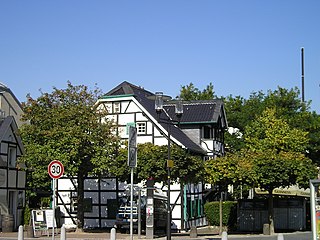
North Rhine-Westphalia or North-Rhine/Westphalia, commonly shortened to NRW, is a state (Bundesland) in Western Germany. With more than 18 million inhabitants, it is the most populous state in Germany. Apart from the city-states, it is also the most densely populated state in Germany. Covering an area of 34,084 km2 (13,160 sq mi), it is the fourth-largest German state by size.

Bergisch Gladbach is a city in the Cologne/Bonn Region of North Rhine-Westphalia, Germany, and capital of the Rheinisch-Bergischer Kreis (district).

Siegburg is a city in the district of Rhein-Sieg-Kreis in North Rhine-Westphalia, Germany. It is located on the banks of the rivers Sieg and Agger, 10 kilometres (6.2 mi) from the former seat of West German government Bonn and 26 kilometres (16 mi) from Cologne. The population of the city was 39,192 in the 2013 census.

Langenfeld is a town in North Rhine-Westphalia (Germany) in the district of Mettmann. The suburban city is located between Düsseldorf and Cologne. Langenfeld was formed from the two localities of Richrath and Reusrath and received city rights in 1948.

Marienheide is a municipality in the Oberbergischer Kreis, in North Rhine-Westphalia, Germany.

Overath is a town in the Rheinisch-Bergischer district of North Rhine-Westphalia, Germany.

Kaarst is a town in Germany. It lies in the district of Rhein-Kreis Neuss in North Rhine-Westphalia. It is 5 km west of Neuss and 12 km east of Mönchengladbach.

Rösrath is a town in the Rheinisch-Bergischer Kreis (district) in North Rhine-Westphalia, Germany. The earliest known documents mentioning the settlement Rösrath can be found in documents dated to 1356. There have been findings of Paleolithic and Mesolithic tools in the town area Forsbach. The community was elevated to the town status in 2001.

Neunkirchen-Seelscheid is a municipality in the Rhein-Sieg district in the southern part of North Rhine-Westphalia, Germany. Beside the two principal places Neunkirchen and Seelscheid there are numerous smaller localities among the municipality.

Meckenheim is a town in the Rhein-Sieg district, in North Rhine-Westphalia, Germany.

Drolshagen is a town belonging to the district of Olpe in the Regierungsbezirk of Arnsberg in North Rhine-Westphalia, Germany, lying roughly 5 km west of Olpe.

Kürten is a village and a municipality in the Rheinisch-Bergischer Kreis, in North Rhine-Westphalia, Germany.

Jüchen is a municipality in the Rhein-Kreis Neuss, in North Rhine-Westphalia, Germany. It is situated approximately 17 km southwest of Neuss and 10 km southeast of Mönchengladbach.

Rheinbach is a town in the Rhein-Sieg-Kreis district (Landkreis), in North Rhine-Westphalia, Germany. It belongs to the administrative district (Regierungsbezirk) of Cologne.

Sankt Augustin is a town in the Rhein-Sieg district in North Rhine-Westphalia, Germany. It is named after the patron saint of the Steyler missionaries, Saint Augustine of Hippo (354-430). The missionaries established the "Saint Augustine Monastery" near the current town centre in 1913. The municipality of Sankt Augustin was established in 1969, and on September 6, 1977, Sankt Augustin acquired town privileges. Sankt Augustin is situated about 8 km northeast of Bonn and 8 km southwest of Siegburg. Sankt Augustin belongs to the economic region of Bonn/Rhein-Sieg as well as the scientific region of Bonn. With over 59,000 inhabitants, it is the second-largest town in the Rhein-Sieg district.

Hamminkeln is a town in the district of Wesel, in North Rhine-Westphalia, Germany. It is situated on the river Issel, approximately 10 kilometers north of Wesel and 15 km south of Bocholt. It is twinned with Sedgefield, United Kingdom and the largest town in the district of Wesel.

The Siegburg–Olpe railway or Agger Valley Railway is a single-tracked, non-electrified branch line in the German state of North Rhine-Westphalia. Part of a direct link from Cologne, only the section from Overath to Gummersbach-Dieringhausen is still in operation. The section of line from Siegburg to Overath and from Dieringhausen to Olpe are closed.

Schlingenbach is a small river of North Rhine-Westphalia, Germany. It is 6.6 km (4.1 mi) long and flows as a left tributary into the Agger near Overath.
The Cologne–Overath railway is a single-track, non-electrified railway in the German state of North Rhine-Westphalia. It was opened in 1910 to connect the historic Siegburg–Olpe railway directly to Cologne and required the construction of the Hoffnungsthal tunnel. The section from Hoffnungsthal to Rösrath partly used the track of the Cologne–Lindlar railway, which is now largely disused west of Bergisch Gladbach. The line, like the Siegburg–Olpe line, is also called the Aggertalbahn, although it leaves the valley of the Agger not far from Overath.
The Oberbergische Bahn is a Regionalbahn rail service running between Cologne Hansaring and Lüdenscheid in the German state of North Rhine-Westphalia (NRW).























